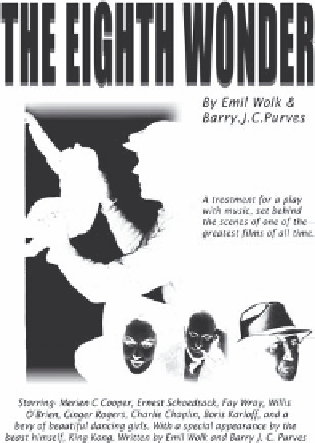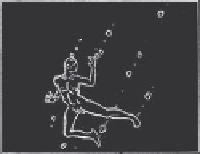Graphics Reference
In-Depth Information
show; he i ghts planes, battles with the long snake-like trains, and climbs to the highest point
on the island of Manhattan. In the i rst half it is Ann who is tied between two pillars, and in the
second, Kong is thus displayed. There are so many parallels and mirrored situations, all full of
potent imagery, that it is hard to believe it was not all planned to the very frame. It is all the
more amazing to think of the i lms being made at the same time. The Depression was still felt,
sound was ever more popular, and the public taste was for upbeat musicals and drawing-room
comedies. Next to Kong, Ginger Rogers and Fred Astaire were
Flying Down to Rio
, and although
nearby Busby Berkeley was in the money from getting his golddiggers to dance as animated
eroticised objects. The sight of Kong snii ng his i ngers after undressing Ann must have been
shocking. Ann in the water revealing a surprising amount of l esh is still provocative, as is the
whole story if taken to its logical conclusion. The i lm has so much sexuality in it, and I'm sure it is
no coincidence that the i rst time we see Ann, she is stealing an apple. Surely all this was thought
through in minute detail. As we have seen puppets saying things their manipulators cannot, is
this puppet acting out what many couldn't help but think?
Researching for a play about King Kong, it was
suggested that Ginger Rogers wanted to play Ann, but
the public perception of her as a wisecracking dancer
worked against her. How dif erent things might have
been. The play focuses on the personalities involved,
drawing larger parallels with the i lm itself, and the
whole act of creating. It was full of quirky ironies, and
we were pleased how we had envisaged not only
putting Kong on stage but theatrically showing the craft
of stop motion. The piece plays with the central ironic
reversal that i rst appealed to me, that of Kong being a
puppet held in a hand while appearing to be holding
a small character in his hand. This l irts with all manner
of ideas about animation and the puppet/puppeteer
relationship. There are even moments where Kong
almost animates Ann, by pushing and shoving her.
The Eighth Wonder
, a yet to be staged
play about Kong.
It is hard to underestimate Kong's signii cance. Watching
the i lm did not make me want to be an animator, as it
did for so many, but it did overwhelm me with its perfection. Everything was just right, from the
Dore-inspired visuals to the wealth of detail (those beautiful cut-out birds giving so much depth,
and which subsequently appear in all my work) and the astonishing use of sound. I only ever felt
cheated by the famous publicity still of Kong looming over the cityscape of New York. The i lm
never delivered that, and thankfully, as it would have veered into totally absurd realms.
At the centre of it all was Kong. Aged eight, I didn't exactly understand the process by which
Kong was created, but I knew he had been created, and that probably the cast
were reacting to something invisible. Today I still marvel how the animation has
been seamlessly inserted into the live action, and vice versa, even both at the same
time. I love the moments when the alive and kicking Fay Wray is dumped on to
the ground, or falls away from the altar, and frames later an animated Fay crawls
away. It's done so l uidly and I hope somewhere there are dozens of storyboards
detailing this.



Search WWH ::

Custom Search